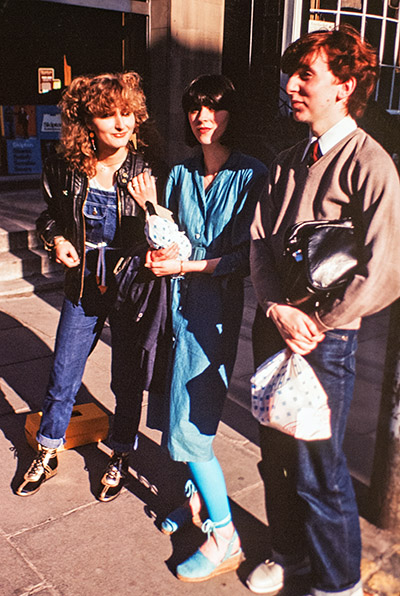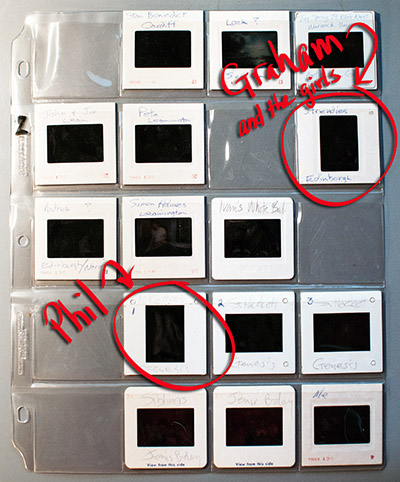(Submitted by Skepticality listener Michael McClure.)
I’ve been working at Disney Animation now for more than 18 years. My son was 11 months old when I started my career at the mouse. He’s now a 19 year old sophomore in college.
We were working on Tarzan a year or so after I started at Disney Animation. I got to know the Artistic Coordinator on the show, a fellow Scot musician named Fraser. One morning he called Support (where I was working at the time), so I took the ticket and went to see him. I had brought in some of my slides in a sleeve (16 slides per sleeve) a few days earlier, because I had a shot of the composer on Tarzan, one Phil Collins. However, instead of the short-haired, balding Phil of the early ’80s, my shot was from a Genesis gig in 1977 at the San Diego Sports Arena, with hirsute Phil (long hair, beard and all!) decked out in the jersey of the farm hockey team from the town that he threw on for the band’s encore of the evening, singing his heart out in a pool of red light. I’d shot the picture 20 years prior, and of course hippie Phil would be relatively unrecognizable to most folks in the late ’90s. The Tarzan production admin folks put out a printed newsletter each week containing the goings on in production-land, and I thought it would be fun to put this picture of Phil into the newsletter, to see if anyone could guess who it was.

Phil Collins, San Diego Sports Arena, 1977 Genesis Concert
I brought the sleeve of slides with me to Fraser’s office, I pulled out the slides to show to him, to see if maybe my musical brethren could guess who the hairy man in the slide was.
Fraser held the sleeve up to the light, and he pondered the picture of Phil for a moment, but I saw his glance drift to one of the other slides in the sleeve. Fraser couldn’t guess who it was, and was amazed when I told him that it was a picture of Phil Collins, but he kept looking at a different slide in the sleeve. Finally, Fraser said, “Can I pull this slide out?” pointing at some random slide I had in the sleeve along with my Genesis concert pictures. I said sure, and he pulled out a picture I’d shot of some random people along Princes Street in Edinburgh, Scotland when I was there with the California Repertory Theater in the summer of 1980 for the Edinburgh Fringe Festival, a huge, yearly theatrical festival held in the city. Fraser inspected the slide very closely, and then looked me in the eye, and said, “This is my best friend Graham.”
“What? Really?”
“Yes. No doubt about it. This is Graham.”

“3 trendies”
Well, that was stunning right there. The picture, as you can tell, shows three trendies (as I wrote on the edge of the slide) whom I stopped on the street that sunny day in August of 1981, and asked in my California twang if I could take their picture. The girls were fine with it, but the boy in the shot was huffy. I think he was annoyed by this ‘foreigner’ bothering them, and showed that by being annoyed and petulant in the picture (but, he was still in the picture!).

The sheet of slides, showing where the two pictures were located.

The “P. Collins” slide

The “3 trendies” slide (dated SEP 80).
Fraser and I had a great can-you-believe-it moment about this, a good laugh, and then we went about our day.
Within 20 minutes, Fraser had called back down to my offices, asking for me. I went back to his office, where I found him, looking even more stunned. After seeing this now 16 or 17 year old picture of his Best Friend, shot by his Support Guy at Disney Animation, he just had to call Graham to tell him about it. So, he did. And things got REALLY weird.
Graham apparently picked up his phone and said hello to Fraser. Fraser explained about the photo, and Graham shrieked in his ear on the phone and hung up. I mean, Fraser said he really SHRIEKED at him, and then abruptly hung the phone up. That was it.
So, Fraser called him back.
Fraser got Graham back on the line, and after a few moments, he drew the story of the shriek and the ensuing hang up out of him. Graham was completely beside himself the entire time they were on the phone. But, in the end, it made perfect sense.
Graham told Fraser that just a few hours earlier THAT SAME DAY, he had had a conversation with his old friend — let’s call her Carol — the small brunette in my photograph. He was attempting to refresh her memory of their other friend — let’s call her Alice — the blonde in the picture. But, Carol wasn’t remembering her. She couldn’t quite place her. Apparently Alice had left Scotland not too long after I’d taken the picture of the three of them in Edinburgh, to marry the bass player of the Bay City Rollers, a then very popular pop group/boy band. She’d gone all the way to New Jersey to marry this guy, apparently. In any case, Graham was trying to remind Carol of this other girl Alice, when he said something to the effect of, “Do you remember when that Yank stopped us on Princes Street years ago and took a picture of the three of us?” hoping that would jar her memory. Maybe it did, or maybe it didn’t — I don’t remember that part. But, Graham hung up with Carol eventually, and then Fraser rung him up from the States soon after that call and said over the staticky international land line, “You’re not going to believe the picture I just saw of you and two girls on Princes Street from the summer of 1981…”
I think I would shriek, too.
Below are the extended notes provided by cognitive psychologist and statistician Barbara Drescher for use in Skepticality Episode 247. Take a look and leave your comments below. Also, please be sure to listen to the podcast for our own hilarious commentary. Also, visit Barbara’s blog.
There are some factors that increase the probability that Fraser would recognize someone in one of the pictures, namely the shared interest in a genre of music and probably the artist. However, it’s a pretty amazing and impressive event. I’ll add that if I was in Graham’s shoes, I would probably shriek, too. These things are bound to happen from time-to-time, of course, so there’s nothing supernatural about it, but that wouldn’t keep my jaw from hitting the floor if this had happened to me.







